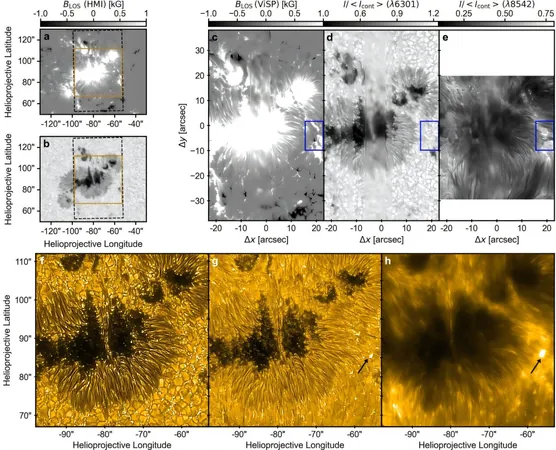
Unveiling the Sun's Secrets: Microflares and Magnetic Reconnection
2025-06-16
Author: Wei
A Groundbreaking Discovery in Solar Research
In an extraordinary breakthrough, scientists using the world's largest solar telescope have captured detailed images of a microflare—an intense yet small explosive event on the sun. This revelation sheds light on the complex magnetic forces that underpin the sun's most subtle outbursts.
The Power of the Daniel K. Inouye Solar Telescope
Led by Dr. João da Silva Santos from the U.S. National Science Foundation's National Solar Observatory, this research harnesses the cutting-edge capabilities of the Daniel K. Inouye Solar Telescope in Maui. The data unveils how magnetic fields in the sun's lower atmosphere can suddenly reconnect, releasing explosive energy—a phenomenon known as magnetic reconnection.
Microflares: Small But Mighty
Though microflares are significantly smaller than their massive counterparts, their energy release is nothing to scoff at—equivalent to about 10 billion lightning bolts! This particular event started with characteristics of the captivating Ellerman bombs before morphing into a complex microflare.
Revealing New Details of Solar Activity
The Inouye's impressive instruments, such as the Visible Broadband Imager and the Visible Spectro-Polarimeter, captured the microflare with remarkable clarity. This enabled scientists to observe eye-opening phenomena like sudden bursts of light and rapid plasma movements just above the solar surface.
Breaking Down the Magnetic Structure
The research identified that the energy release took place in a densely packed area where opposing magnetic fields converged. This resulted in a spectacular display of energy release and movement, akin to snapping rubber bands in a magnetic trap. Dr. Robert Jarolim of NSF NCAR emphasized the groundbreaking nature of these findings, stating they confirm theories previously only suggested by simulations.
Involving the Next Generation of Scientists
Undergraduate student Eric Dunnington from Rensselaer Polytechnic Institute made significant contributions to the research, further highlighting the importance of mentoring young scientists. Dunnington participated in the NSF Research Experiences for Undergraduates program and presented his findings at a leading scientific conference.
Implications for Understanding Space Weather
These insights into small-scale reconnection processes enhance our understanding of how the sun's energy impacts the surrounding space environment. Dr. da Silva Santos articulated the significance of this research in providing some of the clearest observational evidence of magnetic reconnection in compact structures.
A New Era of Solar Exploration
This study not only expands our view into the sun's hidden dynamics but also encourages further exploration of small solar events, which could be key to understanding larger, more catastrophic solar activities. Thanks to the incredible resolution of the Inouye Solar Telescope, the previously invisible sparks of the sun are now coming to light.
 Brasil (PT)
Brasil (PT)
 Canada (EN)
Canada (EN)
 Chile (ES)
Chile (ES)
 Česko (CS)
Česko (CS)
 대한민국 (KO)
대한민국 (KO)
 España (ES)
España (ES)
 France (FR)
France (FR)
 Hong Kong (EN)
Hong Kong (EN)
 Italia (IT)
Italia (IT)
 日本 (JA)
日本 (JA)
 Magyarország (HU)
Magyarország (HU)
 Norge (NO)
Norge (NO)
 Polska (PL)
Polska (PL)
 Schweiz (DE)
Schweiz (DE)
 Singapore (EN)
Singapore (EN)
 Sverige (SV)
Sverige (SV)
 Suomi (FI)
Suomi (FI)
 Türkiye (TR)
Türkiye (TR)
 الإمارات العربية المتحدة (AR)
الإمارات العربية المتحدة (AR)